
The Milan Metro is the rapid transit system serving Milan, Italy, operated by Azienda Trasporti Milanesi. The network consists of 5 lines with a total network length of 104.1 kilometres (64.7 mi), and a total of 113 stations, mostly underground. It has a daily ridership of about 1.4 million on weekdays. The Milan Metro is the largest system in Italy in terms of length, number of stations and ridership; and the seventh longest in the European Union.

The Socimi Eurotram (later sold as the Bombardier Flexity Outlook (E)) was an electric tramcar designed for the tram system of Compagnie de Transports Strasbourgeois (CTS). Initially produced by Socimi, after the company became bankrupt Eurotrams were manufactured first by ABB Group's transportation division, then by Adtranz and finally by Bombardier Transportation, who marketed the tram as part of their Flexity Outlook range.
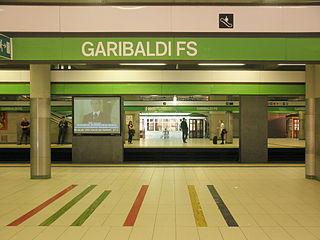
Line 2, is a subway line serving Milan, Italy, operated by ATM as part of the Milan Metro. It is also called the Green Line,, as it is visually identified by green signs.
Azienda Trasporti Milanesi S.p.A. is the municipal public transport company of Milan and 46 surrounding metropolitan municipalities. It operates 5 metro lines, 17 tram lines, 120 bus lines and 4 trolleybus lines, carrying about 776 million passengers in 2018.

Cadorna FN is an underground interchange station in Milan, Italy, serving Lines 1 and 2 of the Milan Metro. The Line 1 station was opened on 1 November 1964 as part of the inaugural section of the Metro, between Sesto Marelli and Lotto. The Line 2 station was opened on 3 March 1978 as the southern terminus of the extension from Garibaldi FS. It served as the southern terminus of Line 2 until the extension of the line to Porta Genova on 30 October 1983.
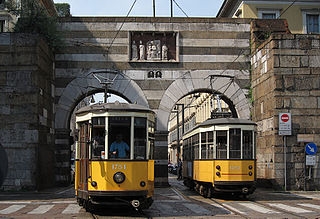
The Milan tramway network is part of the public transport network of Milan, Italy, operated by Azienda Trasporti Milanesi (ATM).

Comasina is a station on Line 3 of the Milan Metro which opened on March 26, 2011, twenty-one years after the opening of the original trunk of the line. Since its opening, it is the northern terminus of the line and one of the four stations on Line 3 opened in 2011, part of the section from Dergano to Comasina.
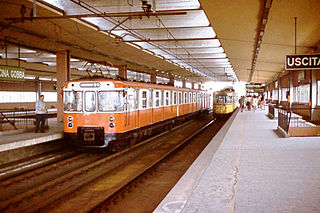
Cascina Gobba is a station on Line 2 of the Milan Metro. The station is located on Via Padova at the west side of the A51 Milan bypass road. This is beside the major highway interchange known as Cascina Gobba, which is the main vehicular transportation hub of northeast Milan, Italy. The line branches here to terminate at either Cologno Nord or Gessate.

San Leonardo is a station on Line 1 of the Milan Metro in Milan, Italy. The station was opened on 12 April 1980 as the western terminus of the extension from Lotto to San Leonardo. On 28 September 1986, the line was extended to Molino Dorino. It is located on Via Gaetano Fichera, in the San Leonardo (Gallaratese) district, from which it takes its name. It is an underground station, located within the urban fare limit.
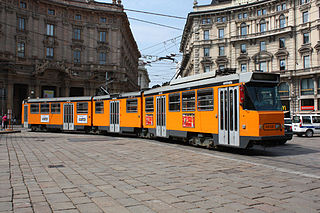
The ATM Class 4900, Nicknamed the "Jumbotram" is a series of articulated trams used by the ATM on the Milan urban tramway network.
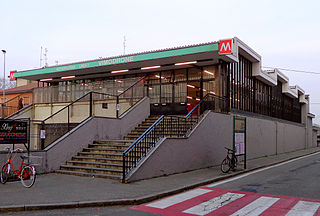
Vimodrone is a suburban station on Line 2 of the Milan Metro in the municipality of Vimodrone.
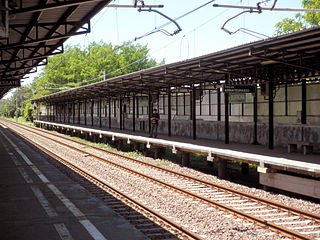
Cascina Burrona is a suburban station on Line 2 of the Milan Metro in the village of Cascina Burrona, which is in the municipality of Vimodrone.

Cernusco sul Naviglio is a suburban station on Line 2 of the Milan Metro in the municipality of the same name.

Villa Fiorita is a suburban station on Line 2 of the Milan Metro in the village of Villa Fiorita, which is in the municipality of Cernusco sul Naviglio.

Cassina de' Pecchi is a suburban station on Line 2 of the Milan Metro in the municipality of the same name.

Bussero is a suburban station on Line 2 of the Milan Metro in the municipality of the same name.
Villa Pompea is a suburban station on Line 2 of the Milan Metro in the locality of Villa Pompea, a suburb of Gorgonzola near the northern Italian city of Milan.

Cascina Antonietta is a station on Line 2 of the Milan Metro in the village of Cascina Antonietta, a suburb of Gorgonzola. It is the station with the lowest number of passengers in the system, with an average of 600 passengers per day in 2018.

Gessate is a suburban station on Line 2 of the Milan Metro serving the town of Gessate.

The Metropolitan City of Milan is a metropolitan city in the Lombardy region of Italy. It is the second most populous metropolitan city in the nation after the Metropolitan City of Rome Capital. Its capital is the city of Milan. It replaced the province of Milan and includes the city of Milan and 132 other comuni. It was first created by the reform of local authorities and then established by the Law 56/2014. It has been operative since 1 January 2015.


















